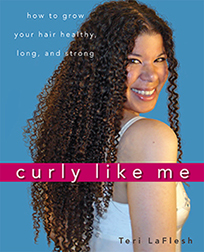
Available now!
Curly Like Me, the off-the-grid, do-it yourself owner's manual for tightly curly hair, is ready for ordering. Grab your copy today!

Every purchase made from
this site (through Amazon)
helps support it — and it
doesn't cost you anything
extra.
|
|
In the ingredient descriptions: Good means that I like to see this in a product's list of ingredients. Okay means this product appears safe for a curly person like me to use. Caution means that this ingredient may not be good in some hair care products, or for some people. Avoid means this ingredient may hurt your hair. If you see this ingredient in a hair product, it's best to put it down and walk away.
|
|
| |
Brassica
(aka Mustard oil)
Caution
This is an oil from the seeds of a mustard plant. It's usually yellowish green with a very strong smell. It can intensely irritate the skin to the point that it can cause blisters if it isn't diluted. May cause allergic reactions [Winter pgs 114 and 359].
See also:
Irritant
Source(s):
Winter
|
Brassicamidopropyl dimethylamine
Caution
This is used in products as a hair and skin conditioner made from both plant sources (from a plant in the Brassicaceae family—the same family as mustard, broccoli, cabbage) and synthetic sources [Gottschalk 12th ed., pg 315].
Marketed as a conditioning ingredient that is better than Cetrimonium chloride, Behentrimonium chloride, and Stearamidopropyl dimethylamine. It is also said to make combing easier. —Since I'm paranoid, I never like to take the word of the actual manufacturer of an ingredient when they tell me it's great. I doubt they would say it's a bad ingredient.
I haven't found any objective information yet on this ingredient, so I researched what it's made from. From what I've gathered (and from pulling out my trusty Organic Chemistry text book), this is very much like Stearamidopropyl dimethylamine but made with a different, yet similar component. It's like using the same train with a different engine. So instead of a Stearic fatty acid (the Stearamidopropyl part), it's made from Brassica oil (the Brassicamidopropyl part).
According to Winter [pg 491], Hunting (Conditioning) [pg 395] and my Organic Chemistry book, it seems that the important element is actually the dimethylamine component. This is known to be pretty alkaline, and so can be corrosive if it isn't properly neutralized. I am putting the same cautions with this as I did with Stearamidopropyl dimethylamine (which is in products I've used and been really happy with the results, though cautious about this ingredient), except slightly more cautious this time because it's made with Brassica oil, a mustard oil, which is known to cause severe skin irritation when applied directly to the skin.—T
See also:
Stearamidopropyl dimethylamine Brassica
Source(s):
Winter Hunting Gottschalck http://www.inolex.com/cosmetic_ingredients/conditioning_ingredients/ProCondition_22
|
|
References:
Applewhite, Thomas H., ed. Proceedings of the World Conference on Lauric Oils: Sources, Processing, and Applications
AOCS Publishing, 1994.
Barel, André O., Marc Paye, and Howard I. Maibach., eds. Handbook of Cosmetic Science and Technology, Second Edition
Marcel Dekker, Inc., 2001.
Begoun, Paula. Don’t Go Shopping for Hair-Care Products Without Me. 3rd Edition.
Renton: Beginning Press, 2005.
Begoun, Paula. The Beauty Bible.
Renton: Beginning Press, 2002.
Begoun, Paula. Don’t Go to the Cosmetics Counter Without Me.
Renton: Beginning Press, 2003.
Bellum, Sarah, ed. The Beauty Brains: Real Scientists Answer Your Beauty Questions
New York: Brains Publishing, 2008.
Gottschalk, Tari E. and McEwen, Gerald N, Jr. PhD, eds. International Cosmetic Ingredient Dictionary and Handbook, Tenth Edition 2004, Volumes 1-4.
Washington D. C.: The Cosmetic, Toiletry, and Fragance Association, 2004.
Halal, John Hair Structure and Chemistry Simplified, Fifth Edition
Albany: Milady, 2002.
Hunting, Anthony L.L. Encyclopedia of Conditioning Rinse Ingredients.
Cranford, NJ: Micelle Press, Inc., 1987.
Hunting, Anthony L.L. Encyclopedia of Shampoo Ingredients.
Cranford, NJ: Micelle Press, Inc., 1983.
Johnson, Dale H. (Ed.). Hair and Hair Care, Cosmetic Science and Technology Series. Vol. 17.
New York: Marcel Dekker, 1997. Print.
Nnanna, Ifendu A. and Jiding Xia., eds. Protein-Based Surfactants: Synthesis: Physicochemical Properties, and Applications (Surfactant Science)
Madison Heights: CRC, 2001.
Quadflieg, Jutta Maria. Fundamental properties of Afro-American hair as related to their straightening/relaxing behaviour.
Diss. U of Rheinisch-Westfälischen Technischen Hochschule Aachen, 2003.
Schueller, Randy and Perry Romanowski, eds. Conditioning Agents for Hair and Skin.
New York: Marcel Dekker, Inc., 1999.
Winter, Ruth M.S. A Consumer's Dictionary of Cosmetic Ingredients: Complete Information About the Harmful and Desirable Ingredients Found in Cosmetics and Cosmeceuticals
New York: Three Rivers Press, 2005.
Zviak, Charles., ed. The Science of Hair Care (Dermatology)
New York: Marcel Dekker, Inc., 1986.
|
|